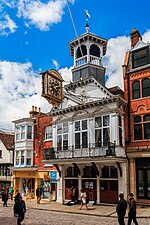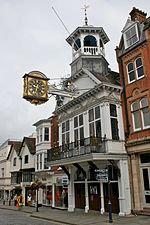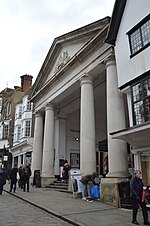The Royal Grammar School, Guildford (originally 'The Free School'), also known as the RGS, is a selective private day school for boys in Guildford, Surrey in England. The school dates its founding to the death of Robert Beckingham in 1509 who left provision in his will to 'make a free scole at the Towne of Guldford'; in 1512 a governing body was set up to form the school. The school moved to the present site in the upper High Street after the granting of a royal charter from King Edward VI in 1552. Around that time, its pupils were playing cricket and their activity was later documented as the earliest definite reference to the sport. The school's Old Building, constructed between 1557 and 1586, is the home of a rare example of a chained library. It was established on the death of John Parkhurst, Bishop of Norwich, in 1575. Although defined as a 'free' school, the first statutes of governance, approved in 1608, saw the introduction of school fees, at the rate of 4 shillings per annum, along with the school's first admissions test. During the late 19th century the school ran into financial difficulty, which nearly resulted in its closure. A number of rescue options were explored, including amalgamation with Archbishop Abbott's School. Funds were eventually raised, however, which allowed the school to remain open, although boarding was no longer offered.Fee paying continued until the school adopted voluntary controlled status under the Education Act 1944; thereafter tuition was free and the common entrance examination at 11 was introduced. Soon after, in 1958, the school expanded with the construction of the New Building in the grounds of Allen House, a building used for a number of years as a boarding house and later as classrooms. Allen House was later demolished in 1964 just after the completion of the New Building. During December 1962 the historic Old Building caught fire, damaging a large part of it, including the two oldest rooms in the school. The damage was so great the reconstruction took over two years. The school became independent and fee paying in 1977, when the parents and staff raised sufficient funds to purchase the school following concerns about the abolition of grammar school status with the introduction of comprehensive education.The school initially educated 30 of the 'poorest men's sons', though has since grown to have approximately 900 students, about 300 of whom are in the sixth form. The majority of pupils, approximately two thirds, enter at age 11 in the first form, a few (3-5 pupils) enter in the second form at the age of 12, with the remainder entering at 13 in the third form. Admissions are based on an entrance examination set by the school, and an interview. The school partakes in a number of sporting activities, and has enjoyed some success, including finishing within the top two in the Daily Mail Cup twice. The school maintains a grammar school ethos, and as such runs a number of outreach programmes for students from local maintained schools, for which it won the Independent School Award 2010 for Outstanding Community/ Public Benefit Initiative. The Headmaster is a member of the Headmasters' and Headmistresses' Conference.










